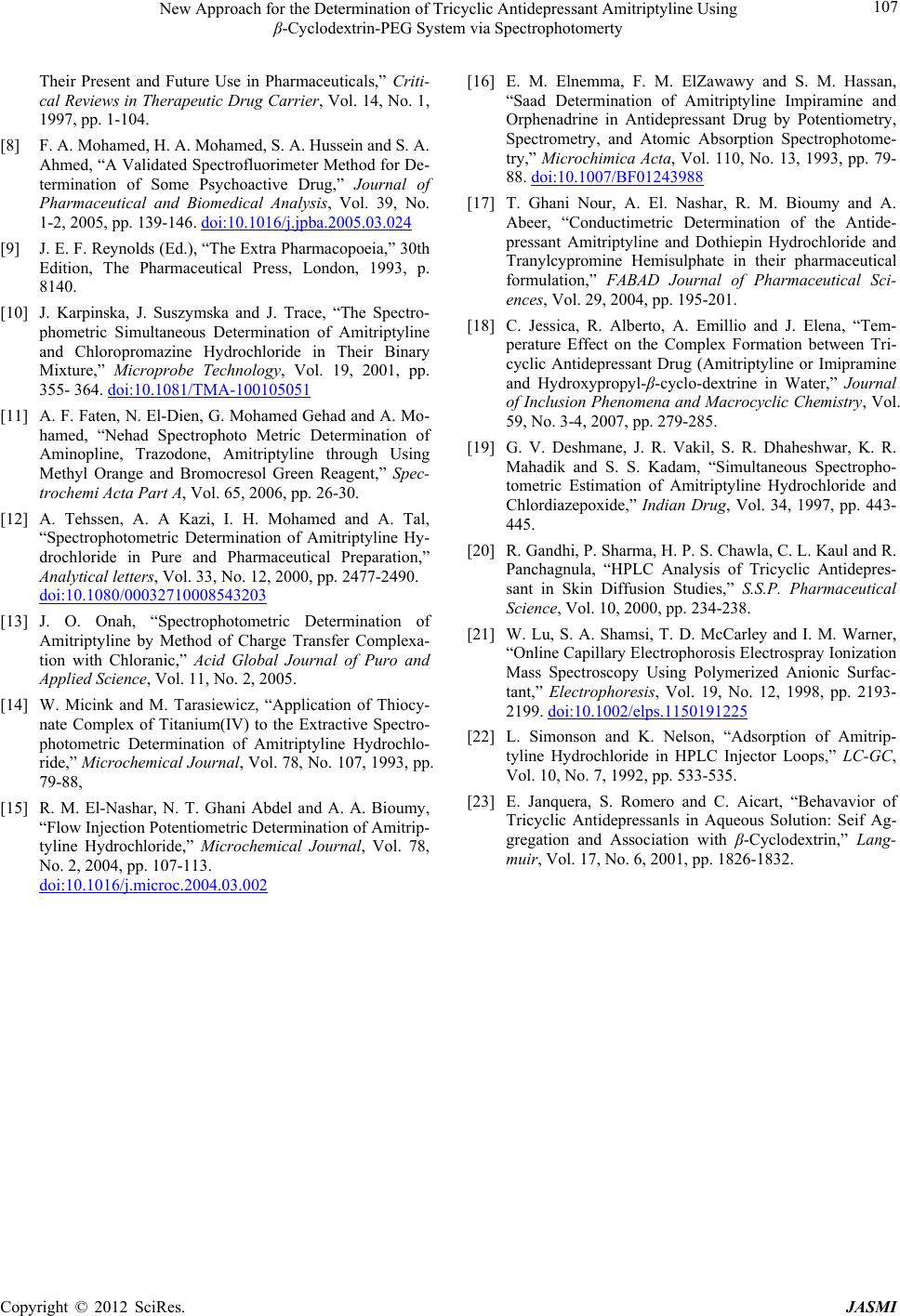
New Approach for the Determination of Tricyclic Antidepressant Amitriptyline Using
β-Cyclodextrin-PEG System via Spectrophotomerty 107
Their Present and Future Use in Pharmaceuticals,” Criti-
cal Reviews in Therapeutic Drug Carrier, Vol. 14, No. 1,
1997, pp. 1-104.
[8] F. A. Mohamed, H. A. Mohamed, S. A. Hussein and S. A.
Ahmed, “A Validated Spectrofluorimeter Method for De-
termination of Some Psychoactive Drug,” Journal of
Pharmaceutical and Biomedical Analysis, Vol. 39, No.
1-2, 2005, pp. 139-146. doi:10.1016/j.jpba.2005.03.024
[9] J. E. F. Reynolds (Ed.), “The Extra Pharmacopoeia,” 30th
Edition, The Pharmaceutical Press, London, 1993, p.
8140.
[10] J. Karpinska, J. Suszymska and J. Trace, “The Spectro-
phometric Simultaneous Determination of Amitriptyline
and Chloropromazine Hydrochloride in Their Binary
Mixture,” Microprobe Technology, Vol. 19, 2001, pp.
355- 364. doi:10.1081/TMA-100105051
[11] A. F. Faten, N. El-Die n, G. Mohamed Gehad and A. Mo-
hamed, “Nehad Spectrophoto Metric Determination of
Aminopline, Trazodone, Amitriptyline through Using
Methyl Orange and Bromocresol Green Reagent,” Spec-
trochemi Acta Part A, Vol. 65, 2006, pp. 26-30.
[12] A. Tehssen, A. A Kazi, I. H. Mohamed and A. Tal,
“Spectrophotometric Determination of Amitriptyline Hy-
drochloride in Pure and Pharmaceutical Preparation,”
Analytical letters, Vol. 33, No. 12, 2000, pp. 2477-2490.
doi:10.1080/00032710008543203
[13] J. O. Onah, “Spectrophotometric Determination of
Amitriptyline by Method of Charge Transfer Complexa-
tion with Chloranic,” Acid Global Journal of Puro and
Applied Science, Vol. 11, No. 2, 2005.
[14] W. Micink and M. Tarasiewicz, “Application of Thiocy-
nate Complex of Titanium(IV) to the Extractive Spectro-
photometric Determination of Amitriptyline Hydrochlo-
ride,” Microchemical Journal, Vol. 78, No. 107, 1993, pp.
79-88,
[15] R. M. El-Nashar, N. T. Ghani Abdel and A. A. Bioumy,
“Flow Injection Potentiometric Determination of Amitrip-
tyline Hydrochloride,” Microchemical Journal, Vol. 78,
No. 2, 2004, pp. 107-113.
doi:10.1016/j.microc.2004.03.002
[16] E. M. Elnemma, F. M. ElZawawy and S. M. Hassan,
“Saad Determination of Amitriptyline Impiramine and
Orphenadrine in Antidepressant Drug by Potentiometry,
Spectrometry, and Atomic Absorption Spectrophotome-
try,” Microchimica Acta, Vol. 110, No. 13, 1993, pp. 79-
88. doi:10.1007/BF01243988
[17] T. Ghani Nour, A. El. Nashar, R. M. Bioumy and A.
Abeer, “Conductimetric Determination of the Antide-
pressant Amitriptyline and Dothiepin Hydrochloride and
Tranylcypromine Hemisulphate in their pharmaceutical
formulation,” FABAD Journal of Pharmaceutical Sci-
ences, Vol. 29, 2004, pp. 195-201.
[18] C. Jessica, R. Alberto, A. Emillio and J. Elena, “Tem-
perature Effect on the Complex Formation between Tri-
cyclic Antidepressant Drug (Amitriptyline or Imipramine
and Hydroxypropyl-β-cyclo-dextrine in Water,” Journal
of Inclusion Phenomena and Macrocyclic Chemistry, Vol.
59, No. 3-4, 2007, pp. 279-285.
[19] G. V. Deshmane, J. R. Vakil, S. R. Dhaheshwar, K. R.
Mahadik and S. S. Kadam, “Simultaneous Spectropho-
tometric Estimation of Amitriptyline Hydrochloride and
Chlordiazepoxide,” Indian Drug, Vol. 34, 1997, pp. 443-
445.
[20] R. Gandhi, P. Sharma, H. P. S. Chaw la, C. L. Kaul and R.
Panchagnula, “HPLC Analysis of Tricyclic Antidepres-
sant in Skin Diffusion Studies,” S.S.P. Pharmaceutical
Science, Vol. 10, 2000, pp. 234-238.
[21] W. Lu, S. A. Shamsi, T. D. McCarley and I. M. Warner,
“Online Capillary Electrophorosis Electrospray Ionization
Mass Spectroscopy Using Polymerized Anionic Surfac-
tant,” Electrophoresis, Vol. 19, No. 12, 1998, pp. 2193-
2199. doi:10.1002/elps.1150191225
[22] L. Simonson and K. Nelson, “Adsorption of Amitrip-
tyline Hydrochloride in HPLC Injector Loops,” LC-GC,
Vol. 10, No. 7, 1992, pp. 533-535.
[23] E. Janquera, S. Romero and C. Aicart, “Behavavior of
Tricyclic Antidepressanls in Aqueous Solution: Seif Ag-
gregation and Association with β-Cyclodextrin,” Lang-
muir, Vol. 17, No. 6, 2001, pp. 1826-1832.
Copyright © 2012 SciRes. JASMI